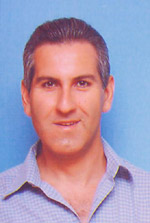
 |
Dror OrgadOffice: Danciger B 214Phone: (972-2) 6586980 Fax: (972-2) 6586168 Email: orgad@phys.huji.ac.il |
||
Research Interests:
In the conventional quantum theory of the electronic structure of
solids the interacting and the free spectra are adiabatically connected,
the strong bare couplings are significantly renormalized and the resulting
state is that of a weakly interacting gas of excitations. In my work I have focused my attention on two problems in particular. The first is the interacting two-dimensional electron gas in a strong magnetic field. This system exhibits a plethora of exotic phenomena such as the fractional quantum Hall effect and the existence of excitations with fractional charge and statistics. In addition to that, the edges of such samples offer a realization of a peculiar state of matter, the "Luttinger liquid", made out of interacting electrons moving in one dimension. I have been interested in its properties and the way it is born out of the physics that governs the bulk of the sample. I have carried my interest in low-dimensional interacting systems
to the field of high temperature superconductivity which currently
constitutes my prime field of study. One concept that has emerged
in this context is the electronic stripe phase in which
the charge carriers spontaneously segregate into one-dimensional
"rivers of charge". There is a growing body of
experimental evidence supporting the existance of such phases
in the cuprate high temperature superconductors and other systems,
most recently in quantum Hall samples. Selected Publications:"From the Chern-Simons
Theory for the Fractional Quantum Hall Effect to the Tomonaga-Luttinger
Model of Its Edges'', D. Orgad, Phys. Rev. Lett. 79,
475 (1997). "Dimensional
Crossover in Quasi-One-Dimensional and High T_c Superconductors'',
E. W. Carlson, D. Orgad, S. A. Kivelson and V. J. Emery, Phys. Rev.
B 62, 3422 (2000). "Evidence
for Electron Fractionalization From Photoemission Spectra in the
High Temperature Superconductors'', D. Orgad, S. A. Kivelson,
E. W. Carlson, V. J. Emery, X. J. Zhou and Z. X. Shen, Phys. Rev.
Lett. 86, 4362 (2001). "Concepts in High Temperature Superconductivity", E. W. Carlson, V. J. Emery, S. A. Kivelson and D. Orgad, review chapter in "The Physics of Superconductors: Superconductivity in Nanostructures, High-Tc and Nivel Superconductors", Vol 2, p. 275-452, edited by K. H. Bennemann and J. B. Ketterson (Springer-Verlag 2004). Present Graduate Students:
Collaborators Outside of the Hebrew University:
|
|||

